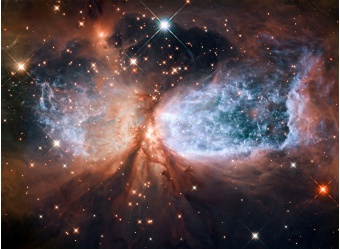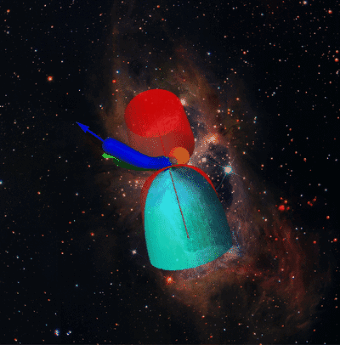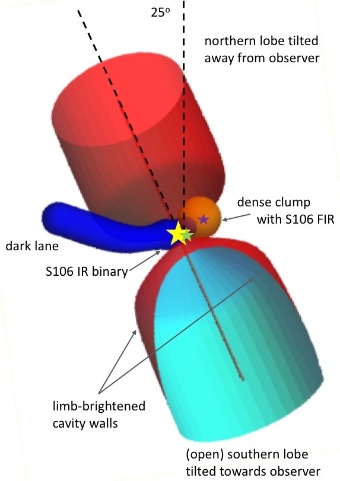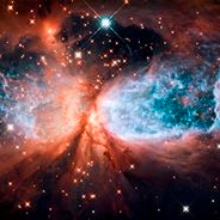-

- Image of the star formation region S106 in the constellation Cygnus
(the swan), taken by the Hubble Space Telescope. In the center is the
young, massive double star S106 IR, which is surrounded by dust, and
is responsible for the hourglass-like shape of the surrounding gas cloud
and the visible turbulence therein. Copyright: NASA & ESA
How exactly do massive stars form in our Milky Way? Dr. Nicola Schneider from the University of Cologne and her international team pursues this question in the GENESIS project S106 by combining observations with SOFIA, the Stratospheric Observatory for Infrared Astronomy, with data from other observatories. These sort of studies are the main objectives of GENESIS, a German-French collaborative project between N. Schneider, R. Simon from the I. Physik. Institut, Cologne and S. Bontemps from the Laboratoire d’Astrophysique of Bordeaux. All stars, even ordinary ones like our Sun, are formed by interstellar gas and dust clouds. These clouds show a complex structure with filaments and clumps. The mass flow along the filaments ends in an accretion disk around the proto star. This disk gradually collects the surrounding matter and finally the star is formed inside. Triggered by this process, additionally ionized gas is ejected perpendicular to the disk in so-called jets. In a low-mass star, these processes occur comparatively ordered in clearly distinguishable phases and altogether last about one million years. If the pressure inside the proto star is high enough, the hydrogen burning (the fusion of hydrogen nuclei to helium) is ignited - the new star is born.
-

- Schematic representation / animation (pleas click) of the S106 region
(Figure 3) projected onto an IR image of the region.
Copyright: M. Röllig & N. Schneider
Massive stars, on the other hand, presumably collapse within only a few thousand years and start
their hydrogen burning, even while the accretion disk is still being formed - the different phases
of star formation do not take place sequentially, but simultaneously and are difficult to study
separately. And in order not to make it too easy for the researchers, the massive stars are usually
not formed individually, but together with one or even several equally massive companions and with
many low-mass stars together.
In order to better understand the different processes and phases involved in the formation of
massive stars, the team headed by Nicola Schneider has now measured the neutral oxygen [OI]
emission line at 63 μm with the German REceiver for Astronomy at Terahertz Frequencies (GREAT)
onboard SOFIA in the star formation area S106 with high frequency accuracy. Using the
high-resolution spectral data provided by this instrument, the astronomer can determine the
different velocity distributions within the gas. A physical model adapted to this data then allows
one to derive the spatial distribution of the element and other important physical parameters
(e.g., density and temperature) of the overall system. Indeed, the data analyzed by Nicola
Schneider confirm that at the center of S106 is a massive binary star system, and that this star
formation area is in a fast and dynamic process of simultaneously accumulating and expelling
material.
-

- The main components of the S106 star formation area: In the center
is the massive double star around which the accretion flow 'winds'
and material is transported to a star in formation. Perpendicular to
this are ionized cavities, also called the HII region.
Copyright: M. Röllig N. Schneider
And there is still no end in sight: Observations with the 30 meter telescope of the Institut de Radioastronomie Millimétrique (IRAM ) in the Spanish Sierra Nevada show that large amounts of cold gas are still plunging into the center of S106 and continue driving these turbulent processes. Shock fronts can additionally influence and change the structure of the star formation area. With the help of SOFIA data and forthcoming observations with the NOEMA interferometer from IRAM, Nicola Schneider now wants to investigate the extent to which shock fronts form on the impact of the hot, ejected gas on the incoming cold gas, and how important filaments are as mass transporters in the star formation
-
![single images of the [OI] line single images of the [OI] line](https://www.dsi.uni-stuttgart.de/img/news/news_picture/1812/32508Schneider.jpg?__scale=h:248,w:340,c:transparent)
- The individual images on this map show how the [OI] emission
changes with speedCopyright: N. Schneider
In the scientific publication on the [OI] 63 μm observations of S106, Nicola Schneider also
describes how she can generally derive the three-dimensional ionization, the density, and the
velocity structure of a star formation region, only from high spectral resolution data. Because of
the far-reaching importance of this template analysis, her article was selected to be the
'highlight paper' of the September issue of
Astronomy and Astrophysics (A & A, 617 (2018) A45).
Further Links
- https://hera.ph1.uni-koeln.de/~nschneid/s106.html
- https://www.astro.uni-koeln.de/GENESIS
- https://www.aanda.org/2018-highlights/1535
- Anatomy of the massive star-forming region S106 the [O I] 63 μm line observed with GREAT/SOFIA as a versatile diagnostic tool for the evolution of massive stars N. Schneider et al., A&A, 617 (2018) A45
Further SOFIA Links
- SOFIA Science Center
- NASA SOFIA Missionsseite
- SOFIA Missionsseite des DLR Raumfahrtmanagements
- DLR SOFIA Projektseite
- DLR Blogs zu SOFIA
Contact: Dörte Mehlert, Email: mehlert@dsi.uni-stuttgart.de; Tel.:0711 - 685-69632
GREAT/upGREAT, the „German Receiver for Astronomy at Terahertz Frequencies“, was developed and built by a consortium of German research institutes (MPI for Radio Astronomy, Bonn and KOSMA/Universität zu Köln, in collaboration with the DLR Institute for Planetary Research, Berlin, and the MPI for Solar System Research, Göttingen). The GREAT Principal Investigator (PI) is Jürgen Stutzki from Cologne University, Deputy Principal Investiogator (Co-PI) in Bernd Klein from MPIfR. The development of the instrument was financed by means of the participating institutes, Max Planck Society and German Research Society.


